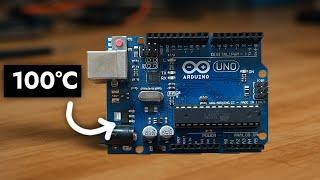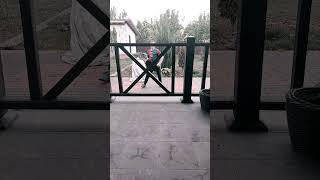Комментарии:

Si no sabía que lo tenía, es que dicho problema no existe y por lo tanto no resuelve nada...
Ответить
Thanks for your clear explanation.
Hint for a next video: how do you solve the eternal problem of powering an Arduino board and a DC motor from the same power supply without causing noise and spikes, causing your Arduino board to freeze, reset or die? Many people, incl. myself, have tried to use a 12V power supply and split the power into 2 power lines: 1 that goes to the motor driver and another one that goes to a buck converter and then to Vin and GND of the Arduino. But despite built-in protection on the BTS7960 the setup still isn't stable. Where did we go wrong?

Great video. Thanks, helps a lot!
Ответить
bro this guy is the only guy who discusses my shower thoughts of the arduino I'm never unsubscribing
Ответить
Buck and boost converters are like magic! Thanks!
Ответить
But this means the R4 is noisier, I wonder what is the impact on DAC and ADC.
Ответить
Would love to see you do more Arduino projects on the channel, especially the ESP-01S
Ответить
TLDW; the r4 has a switching regulator which is more efficient than the r3's linear regulator
but it's also noisier. the best solution would be a switching regulator which makes 7V and then a 5V LDO to get a clean supply rail

I would call the two different types of voltage regulators "linear" and "switching" and not "LDOs" and "DC-DC". Both are clearly DC-DC regulators, so that alone is problematic. The other problem is that "LDO" stands for "Low DropOut". "Linear regulators" are so-called because their voltage-dropping transistor is operated in its linear region to induce the power-wasting voltage drop.
The LDOs typically used on most vendors' R3 boards are NOT LOW dropout, as their drop-out voltages are quite high (typically 1.2-1.5+ volts). An actual LDO has a LOW dropout voltage (hence the name), typically 0.5-0.8V. As one should infer, a linear regulator with a high dropout voltage is NOT an LDO (even its datasheet will concur). Calling all linear regulators "LDOs" is incorrect and isn't an uncommon error, and too many people who should know better continue to do so. The 7805 is the classic definitely-not-an-LDO linear regulator.
As you stated, getting VIN as close to 6.5-7.0V is the way to go. If the project uses low amounts of current, then going to 12V isn't the worst thing in the world and still wastes a relatively large proportion of its input power, but a low(er) absolute amount of power -- which as you noted has a significant impact on the amount of heat generated.

i wish there was a msp channel like this channel is for arduino
Ответить
idk if this is even relevant, but if your room sensor uses IR motion detectors, have you heard of "mmWave human presence sensors"? they're apparently sensitive enough to detect someone from just breathing
Ответить
Great to see a real test with load and the thermal camera showing the difference in temperature between buck converter and linear regulator. I think the title of the video could be improved to reflect the content more closely. Might be interesting to research why Arduino didn't put a buck/boost converted on the R4 to allow powering from single cell lipos.
I'd say the biggest (or maybe first) gotcha in moving from an R3 to R4 uno is the lower voltage on USB power. If users (viewers) aren't aware of that they can do all their development against ~4.7V and then if their final project is powered by the jack it will increase to 5.0V with various possible side effects.
A mention of noise/ripple from the buck converter would be useful even if it's not explored. if you want to do another practical test showing the ripple on a scope in time and frequency domain would be interesting including with some load. And any likely ADC/DAC effects for typical projects.

There are resistors of 50 ohm and 0.5 W
Ответить
There are resistors of 50 ohm and 0.5 W
Ответить
Use a pro mini that uses a fraction of the power an uno uses.
Ответить
If you ever get tired of Arduino, you should become a comedian!🤣🤣🤣Where are you from? Germany, Austria?
Ответить
trash arduinos, use not toy and not overpriced by 50x stm and esp 😂
Ответить
The NeRo from FTDI (2016) and the Seeduino 4.2 (2015) I have both feature switching regulators and there are more clones like this, as per usual, Arduino is late to the game.
And what the R4 does not fix is half-baked design. I looked at the layout of the R4 Minima and the first impression was good. But then I highlighted the 5V net and checked how the decoupling capacitors are placed around the controller. Well, it's bad, pin 11 has a capactitor placed nearby, but in a way that it is barely effective and pins 21 and 39 do not have capacitors at all, C4 and C5 are completely misplaced and if done right, there would be one more 100nF in the design. AVCC0 is layouted ok, but the layout of VREFH0 shows that AVCC0 is ok by chance and not by design. Also there are clear indications that this board was at least partly done with the autorouter and with no regards for the outcome.

quality videos. quality info. quality learning.
Ответить
This is why most of my Projects uses external power module if R3 is involved
Ответить
really cool explanation !
Ответить
Dat resistor 🤣
Ответить
I use the N7805 a drop in replacement for the LM7805. It has as small DC to DC buck converter circuit in it. It hardly gets warm even with 24V+
Ответить


























